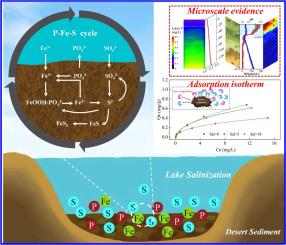中国最大荒漠湖泊红尖湖沉积物磷动态的精细尺度评价
IF 12.4
1区 环境科学与生态学
Q1 ENGINEERING, ENVIRONMENTAL
引用次数: 0
摘要
关于荒漠湖泊磷(P)精细尺度行为的报道很少,这在很大程度上限制了我们对其富营养化过程的全面理解和有效湖泊管理策略的演变。本文首次应用薄膜扩散梯度(DGT)和平面光电(PO)两种先进的高分辨率成像技术,研究了典型沙漠湖泊(红尖湖)沉积物中磷的微观分布和动力学迁移。所有沉积物中活性磷和微环境(如pH、DO、硫化物(S2-)、铁(Fe2+))的高分辨率剖面强调了沉积物中复杂的生物地球化学复杂性和明显的非均质性。其中,活性磷浓度范围为0.10 ~ 0.61 mg/L,平均值为0.33±0.16 mg/L。值得注意的是,在-100 ~ -130 mm深度范围内主要观察到不稳定磷热点的马赛克分布,这可能与沉积物-水界面(SWI)下的不稳定磷活性层相对应。此外,大多数沉积物中不稳定S和P的共分布呈现出显著的相关性(P < 0.01),从而突出了P的流动性与S循环的内在联系。沉积物吸附模拟实验表明,在气候变暖、干燥的条件下,随着沙漠湖泊逐渐盐渍化的加速,红尖湖沉积物P释放的风险逐渐增加。总的来说,这些发现首次在精细尺度上为荒漠湖泊中磷的分布和流动机制提供了有价值的见解,这对于理解这些脆弱生态系统中调节养分循环的复杂生物地球化学过程至关重要。本文章由计算机程序翻译,如有差异,请以英文原文为准。

Fine-scale Evaluation on Phosphorus Dynamics in Sediments of Hongjian Nur, the Largest Desert Lake in China
Very few reports on the fine-scale behavior of phosphorus (P) in desert lakes largely restricts our comprehensive comprehension of their eutrophication processes and the evolution of effective lake management strategies. This study presented the novel application of two advanced high-resolution imaging technologies, i.e., diffusive gradients in thin films (DGT) and planar optode (PO), to investigate the micro-distribution and kinetic mobility of P in sediments of a typical desert lake (Hongjian Nur) for the first time. The obtained high-resolution profiles of labile P and microenvironments (e.g., pH, DO, sulfide (S2-), iron (Fe2+)) in all sediments underscored the intricate biogeochemical complexity and pronounced heterogeneity inherent in the sediments. Specifically, labile P concentrations ranged from 0.10 to 0.61 mg/L with an average value of 0.33 ± 0.16 mg/L. It is noteworthy that the mosaic distribution of labile P hotspots was observed predominantly at depths between -100 mm and -130 mm, which was probably corresponding to the active layer of labile P under the sediment-water interface (SWI). Moreover, the co-distributions of labile S and P in most sediments revealed significant correlations (p < 0.01), thereby highlighting that P mobility is intrinsically linked to the S cycle. Sediment adsorption simulation experiments revealed a gradually increasing risk of P release from Hongjian Nur sediments as the desert lake’s progressive salinization accelerates under a warming, drying climate. Collectively, these findings firstly offer valuable insights into distribution and mobility mechanisms of P in desert lakes at a fine-scale, which are essential to understand the complex biogeochemical processes that regulate nutrient cycling in these fragile ecosystems.
求助全文
通过发布文献求助,成功后即可免费获取论文全文。
去求助
来源期刊

Water Research
环境科学-工程:环境
CiteScore
20.80
自引率
9.40%
发文量
1307
审稿时长
38 days
期刊介绍:
Water Research, along with its open access companion journal Water Research X, serves as a platform for publishing original research papers covering various aspects of the science and technology related to the anthropogenic water cycle, water quality, and its management worldwide. The audience targeted by the journal comprises biologists, chemical engineers, chemists, civil engineers, environmental engineers, limnologists, and microbiologists. The scope of the journal include:
•Treatment processes for water and wastewaters (municipal, agricultural, industrial, and on-site treatment), including resource recovery and residuals management;
•Urban hydrology including sewer systems, stormwater management, and green infrastructure;
•Drinking water treatment and distribution;
•Potable and non-potable water reuse;
•Sanitation, public health, and risk assessment;
•Anaerobic digestion, solid and hazardous waste management, including source characterization and the effects and control of leachates and gaseous emissions;
•Contaminants (chemical, microbial, anthropogenic particles such as nanoparticles or microplastics) and related water quality sensing, monitoring, fate, and assessment;
•Anthropogenic impacts on inland, tidal, coastal and urban waters, focusing on surface and ground waters, and point and non-point sources of pollution;
•Environmental restoration, linked to surface water, groundwater and groundwater remediation;
•Analysis of the interfaces between sediments and water, and between water and atmosphere, focusing specifically on anthropogenic impacts;
•Mathematical modelling, systems analysis, machine learning, and beneficial use of big data related to the anthropogenic water cycle;
•Socio-economic, policy, and regulations studies.
 求助内容:
求助内容: 应助结果提醒方式:
应助结果提醒方式:


